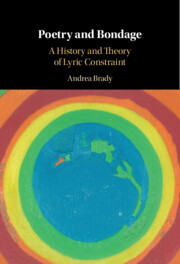Book contents
- Poetry and Bondage
- Poetry and Bondage
- Copyright page
- Dedication
- Contents
- Illustrations
- Acknowledgements
- Introduction The Fetters of Verse
- Part I Lyric Cells
- Part II The Songs of Slavery
- Part III Pleasures and Ornaments
- Chapter 9 A New Made Wound
- Chapter 10 The Ecstatic Lash of the Poetic Line
- Chapter 11 Soft Architecture
- Chapter 12 Silken Fetters
- Index
Chapter 12 - Silken Fetters
Phillis Wheatley and Ornament as Bondage
from Part III - Pleasures and Ornaments
Published online by Cambridge University Press: 08 October 2021
- Poetry and Bondage
- Poetry and Bondage
- Copyright page
- Dedication
- Contents
- Illustrations
- Acknowledgements
- Introduction The Fetters of Verse
- Part I Lyric Cells
- Part II The Songs of Slavery
- Part III Pleasures and Ornaments
- Chapter 9 A New Made Wound
- Chapter 10 The Ecstatic Lash of the Poetic Line
- Chapter 11 Soft Architecture
- Chapter 12 Silken Fetters
- Index
Summary
The book’s final chapter, on the work of Phyllis Wheatley, considers the aesthetics and politics of imitation. Wheatley’s poems both enact and challenge assimilation, by performing a form of Christian whiteness and decorum through acts of imitation for which she has been repeatedly criticised by contemporary readers. But notes of resistance can be heard in her images of chains, oceanic voyages and flight from earthly constraint. Wheatley’s poems transform constraint into ornament, but in a way that ironises her own experiences of capture and enslavement. This introduces a productive incompatibility between the prevailing aesthetic and the experience of bondage that must be overcome if the poem can be written. The chapter argues against contemporary readings of Wheatley as only a ‘sickly little black girl’, for whom whiteness itself was a constraint, and shows how she manages with limited means to particularise dominant poetic traditions to her own experience of enslavement and the Middle Passage.
Keywords
- Type
- Chapter
- Information
- Poetry and BondageA History and Theory of Lyric Constraint, pp. 381 - 413Publisher: Cambridge University PressPrint publication year: 2021

